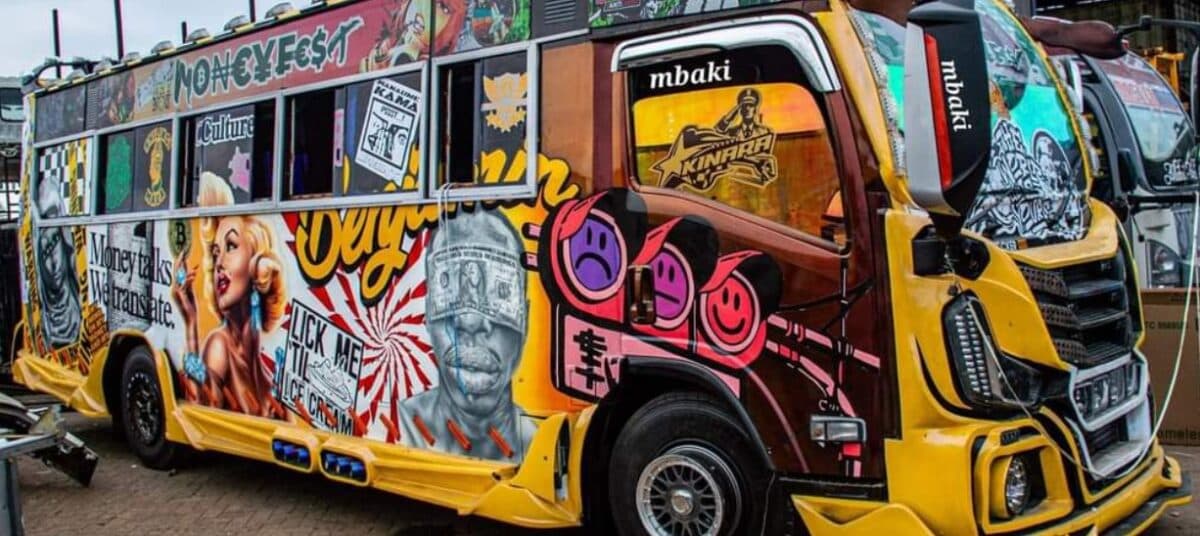We're loading the full news article for you. This includes the article content, images, author information, and related articles.
From neon lights to live DJs, Nairobi’s matatus have morphed into mobile nightclubs—an exuberant, if sometimes controversial, hallmark of city life.

Far from being just a way to get around, Nairobi’s matatus have evolved into mobile canvases for urban youth culture. Once restricted to modest yellow stripes, the city’s vans now bear wild graffiti—portraits of hip-hop icons, pop culture legends, political slogans, and biblical motifs—reflecting socio-political commentary and personal expression. This artistic culture is deeply rooted in youth movements, hip-hop, and street aesthetic in Nairobi .
A striking new chapter in matatu culture is exemplified by the high-end “Mood” vehicle, a matatu reportedly built at a cost of around KSh 14 million. It comes equipped with:
A DJ booth and MC console at the front
Dual 65-inch LED screens
A KSh 2 million sound system
Solar panels that power onboard entertainment
25 plush bucket seats with cup holders in a 2‑1 layout
This setup redefines the commuter experience, transforming travel into an immersive, concert-like event .
These features—loud music (sometimes featuring local drill, gengetone, or reggae), flickering strobe lights, visual art, and danceable space—cater directly to Nairobi’s youth. Their goal? To build a loyal passenger base willing to shell out more for style, ambiance, and experiential value. Riders have called it “a whole vibe … feels like you’re part of a music video” .
Operators investing heavily—sometimes millions of shillings—are not just buying art; they’re creating brand assets.
Revenue potential is high: a flashy matatu can charge premium fares (KSh 100–250 per trip), run daily multiple rounds, and generate solid profits, even after fuel and maintenance costs .
Vehicles such as Mood become social media sensations, attracting crowds and media attention, effectively blending entrepreneurship with performance art .
Nairobi’s matatu industry is more than transit—it’s a fusion zone where art, music, fashion, technology, and youth identity coalesce. It mirrors broader urban culture, connecting unofficial graffiti traditions with digital display screens and sonic branding. These moving pieces of art mark Nairobi out as a global center of expressive city-life innovation .
|
Feature |
Insight |
|---|---|
|
Exterior Style |
Custom graffiti, pop and hip-hop icons, social themes. |
|
Interior Appeal |
DJ booths, giant screens, mood lighting, hi‑fi audio. |
|
Target Market |
Urban youth seeking immersive, social rides. |
|
Business Model |
5 rides, strong branding, high-turnover routes. |
|
Cultural Impact |
Urban identity, entrepreneurial art, global media appeal. |
What was once chaotic scramble for seats has matured into curated journeys—part art installation, part nightlife, entirely Nairobi. By embracing high-end technology, striking visuals, and musical energy, these matatus embody a youthful, entrepreneurial spirit turning everyday transport into social theatre. The phenomenon speaks volumes about how Nairobi’s roads pulse not just with traffic, but with cultural life—and how public transport can reflect the city’s hustle, creativity and ambition.
Keep the conversation in one place—threads here stay linked to the story and in the forums.
Other hot threads
E-sports and Gaming Community in Kenya
Active 7 months ago
Popular Recreational Activities Across Counties
Active 7 months ago
The Role of Technology in Modern Agriculture (AgriTech)
Active 7 months ago
Investing in Youth Sports Development Programs
Active 7 months ago